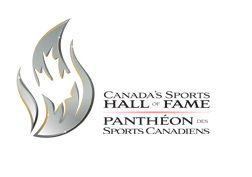Home | Major Sporting Events | Arctic Winter Games
Origin of the Arctic Winter Games
PreviousNext
Sports and activities at the Arctic Winter Games are one way that traditional Indigenous cultures continue to be practiced today. There are two Indigenous communities in Canada that participate at the Games; The Inuit people and also the Dene Nation, who are a First Nations community that spreads as far north as the Arctic Circle.
There are now twenty different sports played at the Games, including mainstream sports like alpine skiing, cross country skiing, basketball, hockey, figure skating, indoor soccer, and wrestling. Over time Indigenous sports have become an increasingly important part of the Games, reflecting the cultures of the Arctic Circle.
Arctic sports - most of which are Inuit sports - began as a demonstration event in 1970. However, by 1974, they became official events at the Games. There are eleven Inuit Sports: One foot high kick, two foot high kick, Alaskan high kick, kneel jump, airplane, one hand reach, head pull, knuckle hop, sledge jump, triple jump, and the arm pull.
In 1974, snowshoeing was introduced as an event, and in 1978, the snowshoe biathlon was established. Dog mushing was introduced to the Arctic Winter Games in 1990.
Also in 1990, the Dene Games became an official event. There are five Dene games at the Arctic Winter Games: Hand game, snow snake, stick pull, pole push, and the finger pull. During the finger pull, the two competitors grasp each other's finger and use their strength, agility, and pain tolerance to wrestle their hands in competition. This type of game was useful for living on the land, as the finger pull can develop skills and strength for pulling fish out of the water.
While Indigenous peoples can thrive in mainstream sports, they also want to participate in activities that are directly related to their cultures. Inuit and Dene activities in the Arctic Winter Games help enable the youth to practice the traditional values and customs of their elders.
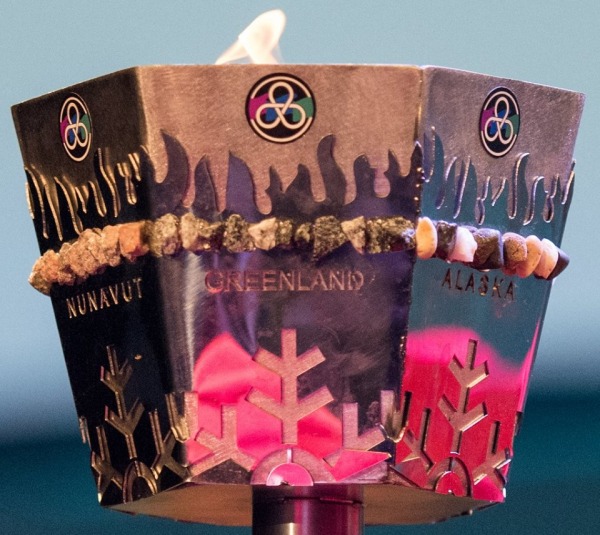
Arctic Sports is one of the most popular events at the Arctic Winter Games having both a national and international following. The spirit of sportsmanship, fellowship and traditional sharing amongst competitors makes it unique in the sporting world. Eleven Arctic Sports are usually included in the Arctic Winter Games experience including the one-foot high kick, two-foot high kick, Alaskan high kick, kneel jump, airplane, one hand reach, arm pull, head pull, knuckle hop, sledge jump and triple jump.
Collection: Arctic Winter Games International Committee
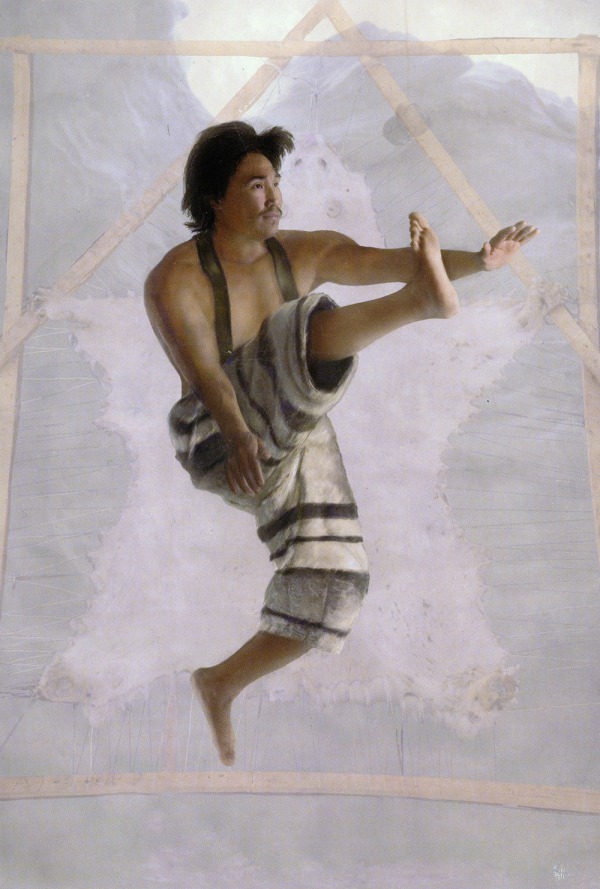
For the one-foot high kick the player begins with a running or standing approach with feet no more than shoulder-width apart at take off. A suspended target must be clearly struck by one foot and the player must land on the same foot with which the target was kicked while maintaining balance and control. The competitor who attains the greatest height is declared the winner.
Collection: Silvia Pecota
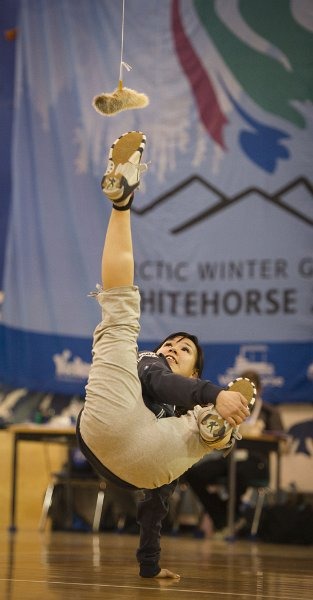
The target used in the one-foot high kick, two-foot high kick and Alaskan high kick is typically a miniature model of a seal which is suspended by a rope from the horizontal arm of the stand. The target in this image is a seal target.
Collection: Arctic Winter Games International Committee
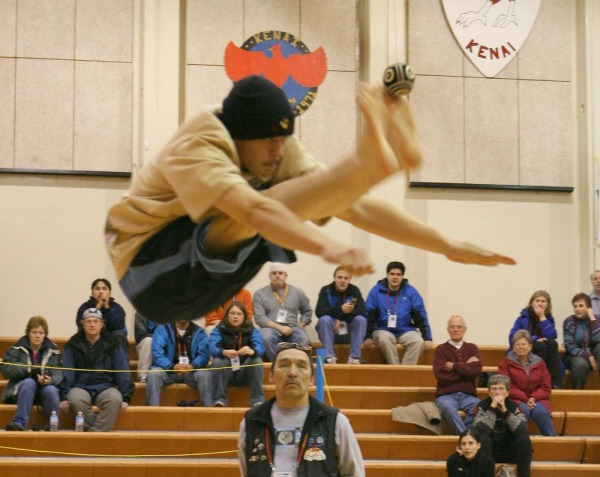
For the two-foot high kick the player begins with a running or standing approach with his or her feet no more than shoulder width apart at take off. The target must be clearly struck with both feet kept parallel. Maintaining balance and control, the competitor must land on both feet at the same time with their feet no more than shoulder width apart. The competitor who attains the greatest height is declared the winner.
Collection: Arctic Winter Games International Committee
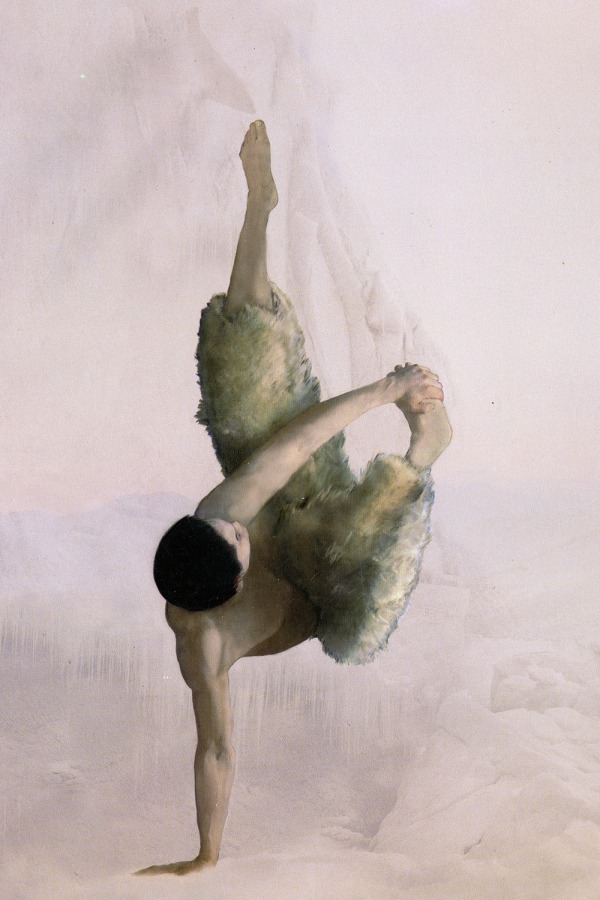
For the Alaskan high kick the player sits on the floor below the target, with one hand grasping the sole of the opposite foot. With the other hand, planted on the floor, the athlete springs up and attempts to kick the target with the free foot. The player must land on the kicking foot and demonstrate clear balance and control. The competitor who attains the greatest height is declared the winner.
Collection: Silvia Pecota
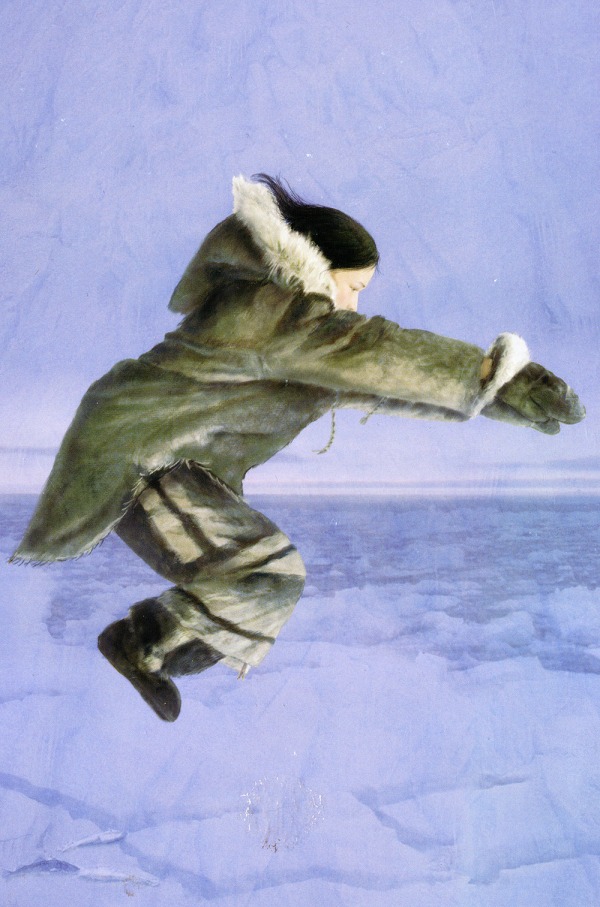
For the Kneel Jump the player begins in a kneeling position, with buttocks resting on his or her heels, toes pointed backward and hands on his or her knees. From this position, the player jumps as far forward as possible, lands on his or her feet in a squatting position while maintaining balance, with the feet planted no further than shoulder width apart. The arms may move back and forth. The competitor who attains the greatest distance is declared the winner.
Collection: Silvia Pecota
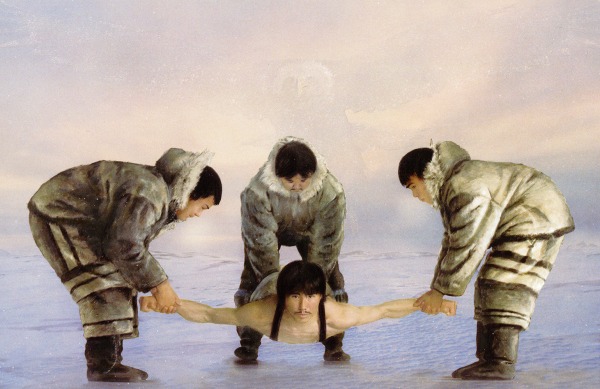
For the Airplane the player lays on the floor face down, with arms straight out in an "iron cross" position. Three assistants lift the competitor two to three feet off the floor and carry him forward at a constant speed over a pre-set course. The competitor's body must remain rigid and fully extended. The attempt ends when the competitor is unable to maintain this body position. The competitor carried the longest distance wins the competition.
Collection: Silvia Pecota
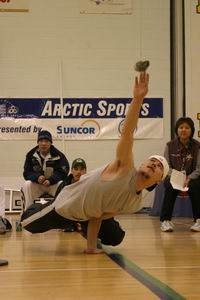
For the One-hand reach the player must brace himself with the elbow of the balancing arm tucked into the body. He begins by lifting his feet off the floor, while balancing on his hands. With one hand the player reaches up to strike the target clearly, while maintaining his balance on the other hand. The striking hand must touch the ground before any other part of the body does so. The player should be positioned so that the target will not be any further away than the fingertips when the arm is extended to the floor.
Collection: Arctic Winter Games International Committee
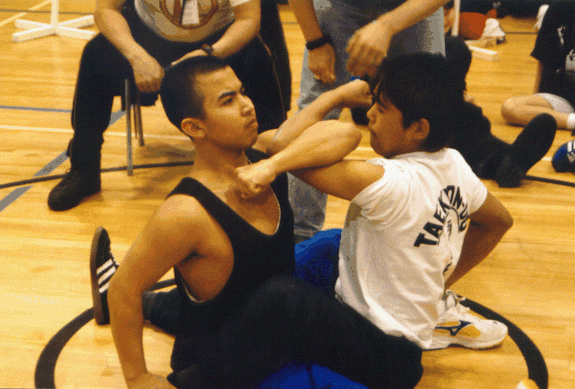
For the Arm Pull, players (in pairs), sit on the floor facing each other and lock right arms at the elbow, with their left hands holding their opponent's right ankle. The left leg is straight and the right leg is bent over the opponent's straightened leg. Competitors pull steadily at the elbow, while bracing their opposite hands on their opponent's ankle. The object is to pull the opponent over or touch the opponent's hand to one's chest.
Collection: Arctic Winter Games International Committee
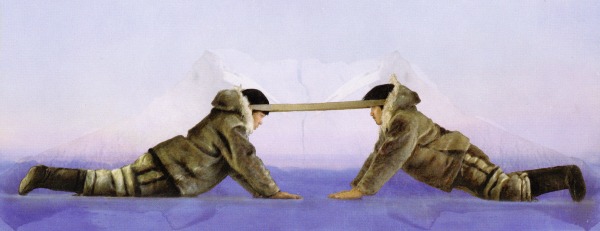
For the head pull two players lie on the floor on their stomachs facing each other. A looped soft leather thong or belt (no metal attachments) is placed over the back of each athlete's head above the ears. Rising to a "push up" position, with only hands and feet touching the floor, the athletes pull with their heads, bracing their hands out in front and using their whole body strength to pull steadily backward. The object is to pull the opponent over a line that is drawn between them. One successful pull determines the winner.
Collection: Silvia Pecota
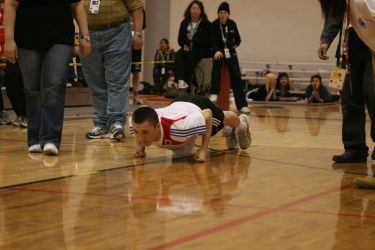
For the knuckle hop the athlete "hops" forward along the floor on a predetermined course on both toes and knuckles simultaneously until he collapses. The body must remain off the floor and is raised upward with each hop to the height of the elbows with the buttocks not to extend above the plane of the body. The competitor who covers the longest distance is declared the winner. Each player is allowed only one attempt.
Collection: Arctic Winter Games International Committee
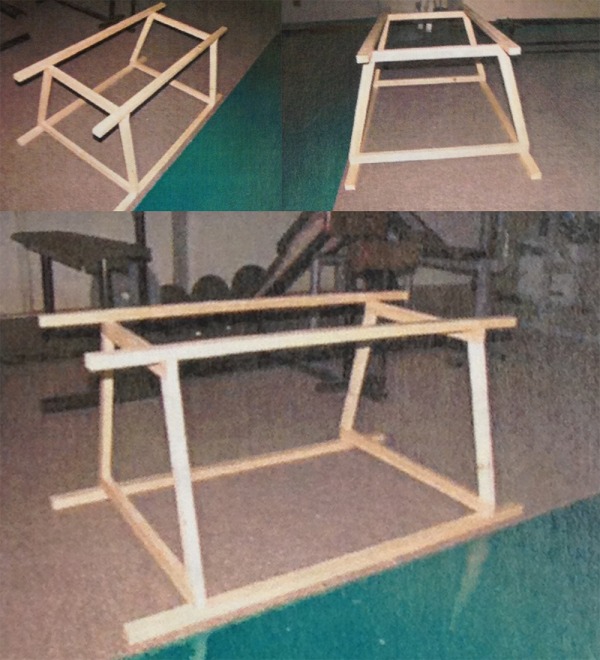
For the sledge jump, the athlete jumps consecutively over ten sledges from a standing position that have been placed parallel to each other on the gym floor. The athlete turns around using one jumping movement, and then proceeds to jump over the ten sledges again. The player continues to jump until they displace one of the sledges with any part of the body, lands or takes off without both feet together or falls. A maximum of five seconds is allowed to turn at either end of the row of the ten sledges. Each player is allowed three attempts, and the attempt in which the player has jumped over the greatest number of sledges is scored. The player who jumps over the greatest number of sledges is declared the winner.
Collection: South Slave Bid Book for the 2018 Arctic Winter Games
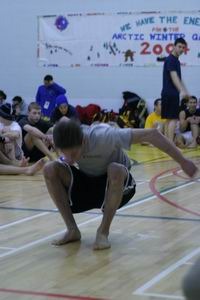
For the triple jump the athlete, using a running or standing start, completes three consecutive jumps. The athlete's feet must remain no more that shoulder width apart. The result is determined by measuring the shortest distance from the back of the starting line to the nearest point touched by any part of the athlete's body. If the jump has been properly completed, the referee will hold a flag in a downward position. The start is a clearly marked line on the floor, completely filled in a by colour different than the surrounding floor.
Collection: Arctic Winter Games International Committee
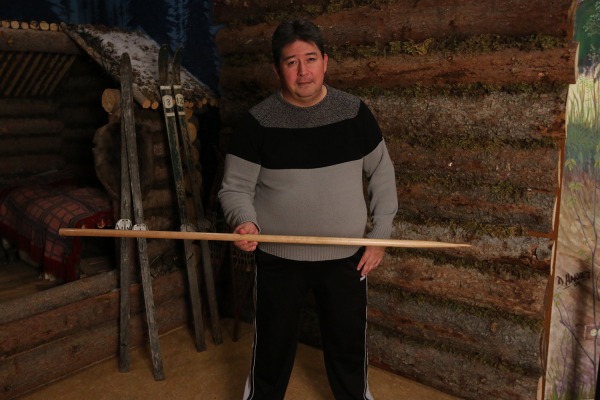
A unique aspect of Dene Games is that coaches and athletes provide technical advice and encouragement to their rivals during competition. Spectators witnessing this for the first time are often amazed at the sportsmanship and camaraderie shown by coaches and competitors. In fact, a positive collective goal of the Dene Games is to maintain traditions of sharing and to help other athletes achieve their best possible results. Peter Daniels is a Dene Games coach who shares the stories and traditions of the Dene Games to ensure all generations know the significance and importance of the Games.
Collection: Peter Daniels, Fort Smith, NWT
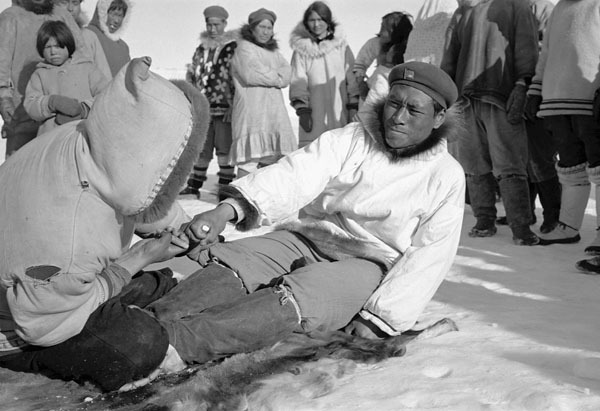
The stick pull was created to practice fish handling techniques. Throughout the winter, either inside or out, playing stick pull provided practice for the grip, strength, and pulling techniques useful for grabbing slippery fish and pulling them back and out of the water. This had to be done with a grip hard enough to hold them, but not so hard as to squeeze them out of one's grip. The action had to be quick and smooth to bring success. This image shows athletes competing in the stick pull event.
Collection: Peter Daniels, Fort Smith, NWT
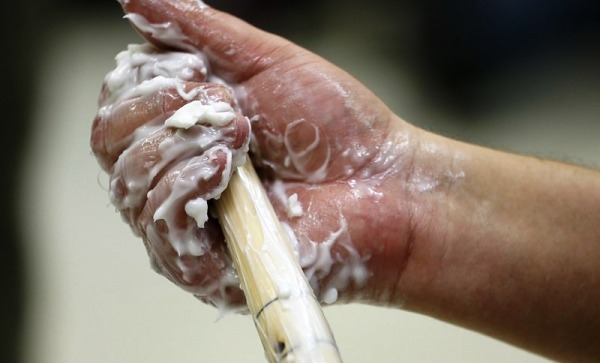
The stick pull provided a fun and challenging way to develop and maintain a skill that contributed to family survival. While traditional grease for the game was bear grease, the current general-purpose grease used is Crisco. This image shows the type of stick used in the stick pull event.
Collection: Peter Daniels, Fort Smith, NWT
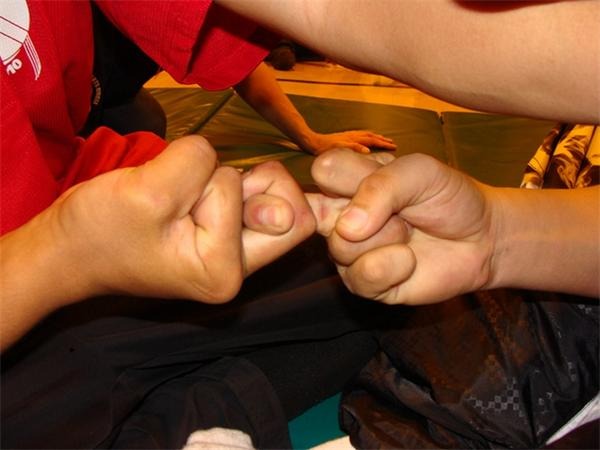
Practiced in camp in all seasons, the Finger Pull strengthened the participant's fingers and increased his or her pain tolerance for very practical purposes. Superior finger strength was invaluable in successful tanning and strong fingers were also required for carrying fish to camp. The easiest way to carry as many fish as possible in one trip was to hook the fingers through the fishes' gills. Those with the strongest fingers, who could tolerate the discomfort of additional weight, could carry the most fish, completing the task efficiently. The finger pull event has two sitting players locking middle fingers, the objective of the offensive player is to break the other player's finger lock or to pull the defensive player's arm forward.
Collection: Peter Daniels, Fort Smith, NWT
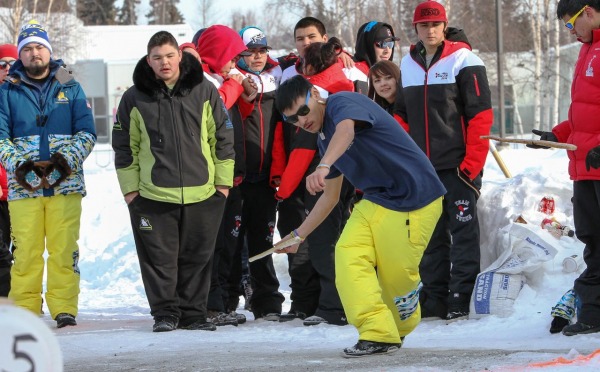
The Snow Snake, originated by throwing a spear along the surface of the snow while caribou, seal, or ptarmigan hunting. Hunting in winter was not an easy task when people had to sneak close to prey in order to make the kill. Finding the prey lying down in the snow, skilled Dene hunters would quietly approach the prey and, from a distance of up to several hundred feet, throw the spear, or snow snake, along the surface of the snow with great force and accuracy into the side of the sleeping animal. Snow Snake might well be considered a game of power but most importantly it is about the technique of throwing the spear with accuracy as shown by the athlete throwing the snow snake during competition.
Collection: Peter Daniels, Fort Smith, NWT
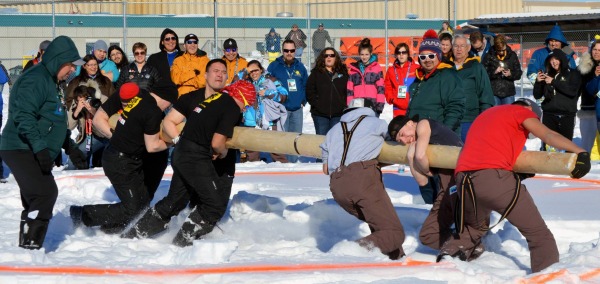
Camp life placed great demands on people, everyone needing to be strong and able to work for long periods of time without tiring. There was no time of year that people could let their strength and endurance diminish. A winter game, pole push was played to increase and maintain strength and endurance. While it was primarily a game played by men, women were welcome to play as well, recognition that the strength of all people was important to the group. As shown in this image, the pole push event includes two teams of four players each grasping the ends of a spruce or pine pole and attempt to push each other out of a marked circle.
Collection: Peter Daniels, Fort Smith, NWT
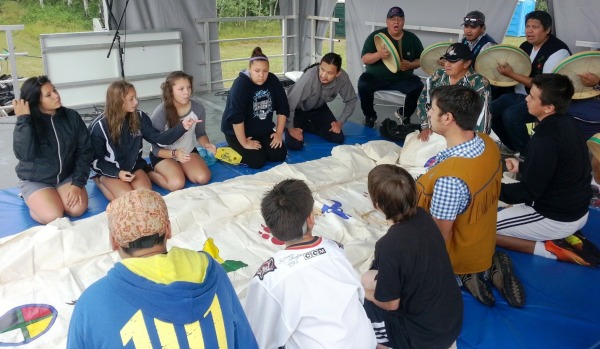
Hand Games were often played at the conclusion of successful hunts following the sharing of the kill and feasting. Hand Games originated with a simple system of hand signals that have evolved to today's version of the game that includes very complex signals requiring careful attention to detail. Two teams of equal numbers kneel on the floor opposite each other. Hiding their hands beneath a blanket, between their thighs, or behind their backs, each member of the playing team shuffles a token from fist to fist while drummers and singers drum and chant to increase the intensity of the game.
Collection: Peter Daniels, Fort Smith, NWT
Previous Next
